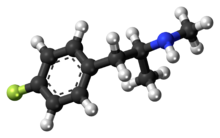4-Fluoromethamphetamine (4-FMA) is a stimulant drug related to methamphetamine and 4-fluoroamphetamine. It has been reported to be sold as a designer drug, but little is known about its pharmacology or toxicology.[2] It was first detected from legal highs sold in Japan in 2006 and became illegal to sell or to possess for the purpose of distribution (although not to simply possess for personal use) in Japan in 2008.[3] It was initially reported to be contained as an ingredient in some of the range of party pills sold internationally by the Israeli company Neorganics from around 2006 onwards, but this was later shown to be incorrect and this ingredient was eventually identified as the closely related compound 2-fluoromethamphetamine.[4]
 | |
 | |
| Legal status | |
|---|---|
| Legal status | |
| Identifiers | |
| |
| CAS Number |
|
| PubChem CID | |
| ChemSpider | |
| UNII | |
| CompTox Dashboard (EPA) | |
| ECHA InfoCard | 100.254.220 |
| Chemical and physical data | |
| Formula | C10H14FN |
| Molar mass | 167.227 g·mol−1 |
| 3D model (JSmol) | |
| |
| |
| | |
Pharmacology
edit4-FMA is a CYP450 inhibitor. It reduces the metabolism of methamphetamine, which has the effect of increasing its potency, duration and systemic toxicity while also reducing its cellular toxicity.[5]
Legal status
editAustralia
edit4-FMA is considered a Schedule 9 substance in Australia under the Poisons Standard (October 2015).[6] A Schedule 9 substance is a substance which may be abused or misused, the manufacture, possession, sale or use of which should be prohibited by law except when required for medical or scientific research, or for analytical, teaching or training purposes with approval of Commonwealth and/or State or Territory Health Authorities.[6]
Canada
editAs of 1996, 4-FMA is a controlled substance in Canada, due to being an analog of methamphetamine.[1]
China
editAs of October 2015 4-FMA is a controlled substance in China.[7]
Finland
editScheduled in the "government decree on narcotic substances, preparations and plants" and is therefore illegal.[8]
United States
editAs a close analog of scheduled controlled substance,[2] sale or possession of 4-FMA could be potentially be prosecuted under the Federal Analogue Act.[9]
See also
edit- 2-Fluoromethamphetamine (2-FMA)
- 3-Fluoromethamphetamine (3-FMA)
- 3-Fluoroethamphetamine (3-FEA)
- 4-Fluoroamphetamine (4-FA)
- 4-Fluoromethcathinone (4-FMC)
- 4-Methylmethamphetamine (4-MMA)
- 4-Methoxymethamphetamine (PMMA)
- Fenisorex
References
edit- ^ a b Branch, Legislative Services (2022-03-31). "Consolidated federal laws of Canada, Controlled Drugs and Substances Act". laws-lois.justice.gc.ca. Archived from the original on 2022-06-11. Retrieved 2022-08-11.
- ^ a b Rösner P, Quednow B, Girreser U, Junge T (March 2005). "Isomeric fluoro-methoxy-phenylalkylamines: a new series of controlled-substance analogues (designer drugs)". Forensic Science International. 148 (2–3): 143–56. doi:10.1016/j.forsciint.2004.05.003. PMID 15639609.
- ^ Nagashima M, Seto T, Takahashi M, Suzuki J, Yasuda I (2006). "Spectrum Data of the 3rd Governor-designated Drugs and the Analyses of Uncontrolled Drugs Purchased" (PDF). Tokyo Metropolitan Institute of Public Health Annual Report (in Japanese). 57: 109–113. Archived from the original (PDF) on 2011-07-22. Retrieved 2007-12-10.
- ^ Camilleri A, Johnston MR, Brennan M, Davis S, Caldicott DG (April 2010). "Chemical analysis of four capsules containing the controlled substance analogues 4-methylmethcathinone, 2-fluoromethamphetamine, alpha-phthalimidopropiophenone and N-ethylcathinone". Forensic Science International. 197 (1–3): 59–66. doi:10.1016/j.forsciint.2009.12.048. PMID 20074881.
- ^ Cherner M, Bousman C, Everall I, Barron D, Letendre S, Vaida F, et al. (September 2010). "Cytochrome P450-2D6 extensive metabolizers are more vulnerable to methamphetamine-associated neurocognitive impairment: preliminary findings". Journal of the International Neuropsychological Society. 16 (5): 890–901. doi:10.1017/S1355617710000779. PMC 3543816. PMID 20727252.
- ^ a b "Poisons Standard". Federal Register of Legislation. Australian Government. October 2015.
- ^ "关于印发《非药用类麻醉药品和精神药品列管办法》的通知" (in Chinese). China Food and Drug Administration. 27 September 2015. Archived from the original on 1 October 2015. Retrieved 1 October 2015.
- ^ https://finlex.fi/fi/laki/ajantasa/2008/20080543
- ^ "Federal Controlled Substance Analogue Act Summary". Erowid Analog Law Vault.